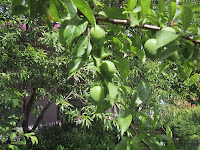Sorry it has been so long, but I finally have some time to post to Fruitful Labor, and with the most exciting news. Polly, my partner, and I besides enjoying a fabulous summer of berry picking and eating....... bought a house! Yes, we are now adults in the most urban sort of way. The even more exciting news about our house is the yard. 50' x 130' of blank lawn. Yes, that is a yard with nothing in it but grass and that means only one thing for Polly and I; ripe out the lawn and put in a huge neighbor to neighbor garden. Yipeeee! After many years of rentals with no space, we have reached the golden age of yardum with enough room for 10, count them, 10 dwarf fruit trees. Which gets me to my next project on this much neglected blog site, a documentary of the transition to lawn blight to garden oasis. Yes, tune in for updated pictures, news, and plain old tales from the burbs. Coming soon, more fresh produce than we can imagine. Ah, it keeps me up at night thinking of the possibilities.
Polly and I just picked out our fruit tree varieties today and will include: Akane, Cox's Orange Pippin, and Hudson's Golden Gem apples, Greengae plum, Chojuro and Dan Bae Asian Pears, Hachiya and Fuyu persimmon, and Rescue and Red Clapps Favorite European Pears. We will also plant a hardy kiwi for the fence and are going to brave an Improved Meyer Lemon in a large pot that we can put in our sunny garage during winter. Yummy and exciting.
So stay tuned for the next adventures and urban tales.
Ciao for now.

Our Backyard (Read Huge Garden)

Looking North in the Backyard (the white stakes are tree planting markers and we have begun to lay down a mulch of cardboard followed by a thick layer of woodchips)

Woodchip Mountain in Front Yard












